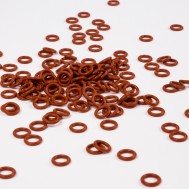Viton® and Buna are two of the most commonly used elastomers for rubber seals and sealing devices. These materials are known to be universal o-rings that offer excellent resistant properties and reliability.
While there are many similarities between the Viton® and Buna o-rings, such as compression set, oil and lubricant resistance, there are key differences that set the two apart. Before you make the choice between Viton® and Buna for your application, here’s a closer look at how the materials compare.
Noteworthy Capabilities
Both Viton® and Buna o-rings have distinct capabilities that make them reliable for a wide range of industries.
Buna o-rings:
- Excellent resistance to petroleum-based oils and fuels, silicone greases, hydraulic fluids, water and alcohols
- Low compression set
- High tensile strength
- Abrasion resistance
- Superior performance in ethanol/methanol blended gasoline
Viton® o-rings:
- High temperature resistance
- Outstanding chemical resistance
- Low compression set
- Ozone resistant
- Low outgassing
While both materials have high resistance capabilities, Viton® o-rings are capable of withstanding higher temperatures while Buna o-rings offer better lower temperature performance.
Key Uses
Viton® and Buna o-rings are often used in similar applications. With resistance to oils and fuels, both materials are typically used in aircraft and automotive applications. However, since Buna offers great resistance to water, Buna o-rings are often used in marine applications as well.
Crucial Differences
Viton® and Buna have a few major differences that are extremely important to note during material selection. While both materials are suitable for moderate temperature applications, Viton® is the superior choice for high temperatures. Viton® standard compounds can withstand temperatures up to 446℉, while Buna o-rings can only handle up to 257℉. Conversely, when it comes to low temperature applications, Buna outperforms Viton®—withstanding temperatures down to -40℉ while standard Viton® can only handle down to -13℉.
Additionally, environmental factors set these materials apart. While Viton® offers excellent resistance to chemicals, it can also withstand the effects of ozone. Buna o-rings, however, are not suitable for ozone or weather exposure and will begin to degrade when exposed.
While both materials offer excellent capabilities and are similar in many ways, the key differences between the two are crucial when deciding between Viton® and Buna for your sealing application.
Want to talk more about Viton® and Buna o-rings?
Tweet us @AppleRubber to continue the conversation.
